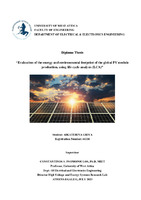| dc.contributor.advisor | Psomopoulos, Constantinos | |
| dc.contributor.author | Γρίβα, Αικατερίνα | |
| dc.date.accessioned | 2023-07-30T20:30:26Z | |
| dc.date.available | 2023-07-30T20:30:26Z | |
| dc.date.issued | 2023-07-25 | |
| dc.identifier.uri | https://polynoe.lib.uniwa.gr/xmlui/handle/11400/4914 | |
| dc.identifier.uri | http://dx.doi.org/10.26265/polynoe-4752 | |
| dc.description.abstract | The rapid growth of photovoltaic (PV) technology has established it as a key player in global renewable energy production. However, the environmental impact associated with the production of PV modules warrants careful analysis. This study aims to assess the emissions generated during the manufacturing process of PV modules, focusing on three major production countries: Europe, the United States, and China. To achieve this objective, the electricity mixes as well as the greenhouse gas emission intensity of the countries were evaluated, considering the various sources used for electricity generation. By analyzing the energy mixes and by using European Union's life cycle analysis for photovoltaic modules and various datasheets, we gained insights into the emissions from diesel combustion, carbon dioxide (CO2) emissions, non-methane volatile organic compounds (NMVOC), and energy consumption associated with PV module production. The data encompassed the entire lifecycle, from raw material extraction to the final product. The findings revealed significant variations in emissions profiles among the production countries. Europe demonstrated a lower carbon footprint due to a higher utilization of renewable energy sources in the manufacturing process. Conversely, the United States exhibited moderate emissions, influenced by a mix of renewable and non-renewable energy sources. China, while a dominant producer, displayed higher emissions, primarily driven by a greater reliance on coal-fired power plants. Overall, this thesis seeks to shed light on the environmental implications of PV module production, offering a comprehensive understanding of the factors influencing their sustainability. Through rigorous analysis and exploration of potential solutions, it aspires to contribute to the broader goal of transitioning towards a greener and more sustainable energy future. | el |
| dc.format.extent | 57 | el |
| dc.language.iso | en | el |
| dc.publisher | Πανεπιστήμιο Δυτικής Αττικής | el |
| dc.rights | Αναφορά Δημιουργού - Μη Εμπορική Χρήση - Παρόμοια Διανομή 4.0 Διεθνές | * |
| dc.rights | Attribution-NonCommercial-NoDerivatives 4.0 Διεθνές | * |
| dc.rights.uri | http://creativecommons.org/licenses/by-nc-nd/4.0/ | * |
| dc.subject | Φωτοβολταϊκά πλαίσια | el |
| dc.subject | Φωτοβολταϊκά πάνελ | el |
| dc.subject | Ενεργειακό μείγμα | el |
| dc.subject | CO2 | el |
| dc.subject | Ανάλυση κύκλου ζωής (LCA) | el |
| dc.subject | Παραγωγή φωτοβολταϊκών | el |
| dc.subject | Emissions | el |
| dc.subject | Energy mixes | el |
| dc.subject | Life cycle analysis | el |
| dc.subject | Photovoltaic production | el |
| dc.subject | Photovoltaic modules | el |
| dc.subject | Εκπομπές αερίων | el |
| dc.title | Evaluation of the energy and environmental footprint of the global PV module production, using life cycle analysis (LCA) | el |
| dc.title.alternative | Εκτίμηση του ενεργειακού και περιβαλλοντικού αποτυπώματος της παγκόσμιας παραγωγής Φ/Β γεννητριών, χρησιμοποιώντας τεχνικές ανάλυσης κύκλου ζωής (LCA) | el |
| dc.type | Διπλωματική εργασία | el |
| dc.contributor.committee | Καλκάνης, Κωνσταντίνος | |
| dc.contributor.committee | KALOGEROPOULOU, SOFIA | |
| dc.contributor.faculty | Σχολή Μηχανικών | el |
| dc.contributor.department | Τμήμα Ηλεκτρολόγων και Ηλεκτρονικών Μηχανικών | el |
| dc.description.abstracttranslated | Η ταχεία ανάπτυξη της τεχνολογίας φωτοβολταϊκών (ΦΒ) την κατέστησε καίριο παράγοντα στην παγκόσμια παραγωγή ανανεώσιμης ενέργειας. Ωστόσο, ο περιβαλλοντικός αντίκτυπος που σχετίζεται με την παραγωγή φωτοβολταϊκών μονάδων απαιτεί προσεκτική ανάλυση. Η μελέτη που διεξάγεται στοχεύει στην αξιολόγηση των εκπομπών που παράγονται κατά τη διαδικασία παραγωγής των φωτοβολταϊκών μονάδων, εστιάζοντας στις τρεις κύριες χώρες παραγωγής: την Ευρώπη, τις Ηνωμένες Πολιτείες και την Κίνα. Για την επίτευξη αυτού του στόχου, αξιολογήθηκαν τα μείγματα ηλεκτρικής ενέργειας καθώς και η ένταση εκπομπής αερίων του θερμοκηπίου των χωρών, λαμβάνοντας υπόψη τις διάφορες πηγές που χρησιμοποιούνται για την παραγωγή ηλεκτρικής ενέργειας. Αναλύοντας τα ενεργειακά μείγματα και χρησιμοποιώντας την ανάλυση του κύκλου ζωής της Ευρωπαϊκής Ένωσης για φωτοβολταϊκά στοιχεία και διάφορα δεδομένα κατασκευής τους, αποκτήσαμε πληροφορίες για τις εκπομπές από την καύση ντίζελ, τις εκπομπές διοξειδίου του άνθρακα (CO2), τις πτητικές οργανικές ενώσεις μη μεθανίου (NMVOC) και την κατανάλωση ενέργειας που σχετίζεται με την παραγωγή φωτοβολταϊκών μονάδων. Τα δεδομένα συμπεριέλαβαν ολόκληρο τον κύκλο ζωής, από την εξόρυξη πρώτων υλών έως το τελικό προϊόν. Τα ευρήματα αποκάλυψαν σημαντικές διακυμάνσεις στα προφίλ εκπομπών μεταξύ των χωρών παραγωγής. Η Ευρώπη επέδειξε μικρότερο οικολογικό αποτύπωμα λόγω της μεγαλύτερης αξιοποίησης ανανεώσιμων πηγών ενέργειας στη διαδικασία κατασκευής. Αντίθετα, οι Ηνωμένες Πολιτείες εμφάνισαν μέτριες εκπομπές, επηρεασμένες από ένα μείγμα ανανεώσιμων και μη ανανεώσιμων πηγών ενέργειας. Η Κίνα, παρόλο που είναι ένας κυρίαρχος παραγωγός, εμφάνισε υψηλότερες εκπομπές, κυρίως λόγω της μεγαλύτερης εξάρτησής της από εργοστάσια παραγωγής ηλεκτρικής ενέργειας με άνθρακα. Συνολικά, αυτή η διπλωματική επιδιώκει να ρίξει φως στις περιβαλλοντικές επιπτώσεις της παραγωγής φωτοβολταϊκών πάνελ, προσφέροντας μια συνολική κατανόηση των παραγόντων που επηρεάζουν τη βιωσιμότητά τους. Μέσα από αυστηρή ανάλυση και εξερεύνηση πιθανών λύσεων, επιδιώκει να συμβάλει στον ευρύτερο στόχο της μετάβασης προς ένα πιο πράσινο και βιώσιμο μέλλον ενέργειας. | el |


